Bulletin #1075, Tarping in the Northeast: Tarping Practices
Table of Contents
- “Stale seedbedding” with tillage and tarps
- Minimizing tillage with tarps
- Cover crop-based rotational no-till with tarps
- Continuous no-till with deep compost mulch and tarps
- Bringing sod into production
- Overwintering for early season production
“Stale seedbedding” with tillage and tarps
Introduction
Stale seedbedding is a practice that encourages the germination of weed seeds, then kills emerged weeds before crop planting in order to minimize weed competition with the crop. The practice reduces in-season weed competition and can also deplete the weed seed bank, leading to reduced weed pressure in subsequent seasons (Gallandt, 2006). Tarps can be used for enhanced stale seedbedding.
Typically, stale seedbedding is done over a period of several weeks in the spring or early summer. Fields are prepared for planting with primary and secondary tillage, and raised beds may be made before applying this practice. These early-season soil disturbances help stimulate a “flush” of weed seeds to germinate. In traditional stale seedbedding, emerged white thread or cotyledon-stage weeds are killed with flaming, cultivation, or herbicide. When tarps are used for stale seedbedding, they are applied soon after field preparation, and kept in place for two or more weeks to allow time for weed seeds to germinate and be killed (Marenco and Lustosa, 2000).
Both occultation and solarization can enhance the flush of weeds by altering the soil’s thermal and temperature regime. Emerged weeds are killed either from the absence of light (occultation) or extreme heat (solarization). Because it targets the seed bank, stale seedbedding is typically more effective for annual weeds than perennials. After tarp removal, crops should be seeded or transplanted into the prepared field with little additional soil disturbance – and certainly without further deep tillage or heavy cultivation – since disturbing soil can bring more deeply buried weed seeds to the soil surface, reducing the in-season benefit of the practice.
Farmers and researchers in the Northeast have had success with occultation and solarization for stale seedbedding in both fields and hoop houses (Birthisel et al., 2019; Fortier and Bilodeau, 2014). A key benefit to this practice is reducing the number of hand weeding, cultivation, or flaming passes needed by at least one. This results in less field traffic and fuel use. Under good conditions, solarizing can also create a better (less weedy) stale seedbed than is possible with other stale seedbedding techniques, potentially saving time and money on cultivation and hand weeding throughout the growing season while retaining valuable nitrate in the soil (Birthisel and Gallandt, 2019).
Logistics
Stale seedbedding with tarps can occur anytime during the growing season, especially in hoop houses. When applied in open fields, it is most commonly done in the springtime. For solarization, effectiveness is greatest near the summer solstice when solar energy gain is at a maximum.
Two weeks is a minimum time frame needed to establish a stale seedbed with tarping. This is based on the time required for many weed seeds to germinate and subsequently be killed. Farmer experience suggests that shorter treatment times may be effective in some circumstances. Research conducted in Maine found that four-six weeks does not typically lead to greater weed suppression than two (Birthisel and Gallandt, 2019).
Amendments that need to be incorporated into soils should be applied before tarping, so that field operations that could unearth buried weed seeds are not needed after tarp removal. Incorporating organic amendments before tarping may also improve the effectiveness of this practice by increasing microbial activity and microbial seed decay.
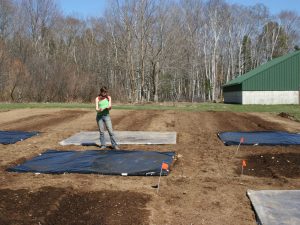
There are key trade-offs when considering occultation vs. solarization for stale seedbedding. Solarization is a higher-risk, higher-reward scenario. Under ideal conditions and when correctly applied (i.e. when plastic is applied over moist soils with edges tightly secured) and the weather is hot and sunny, solarization results in higher soil temperatures, more weed seed bank depletion, and better subsequent weed control than occultation (Birthisel et al., 2018). However, because light can penetrate clear plastic tarps, solarization is more likely to ‘fail’ if conditions are not ideal, calling for subsequent occultation, tillage, or other practice to control weeds. Occultation is, by comparison, a lower-risk, lower-reward strategy: it is unlikely to fail in ways that cause a ‘mess’ that must be cleaned up through subsequent flaming or cultivation, but maximum effectiveness for depleting the seed bank is lower.
Effects and outcomes from stale seedbedding with tarps
Stale seedbedding with tarps has proven effective at reducing weed density across a range of summer annual weeds including hairy galinsoga (Galinsoga quadriradiata Cav.), redroot pigweed (Amaranthus retroflexus L.), lambsquarters (Chenopodium album L.), and crabgrass species (Digitaria spp.). Solarization decreased subsequent weed density by 78% in Maine in comparison to a stale seedbed created with flaming, demonstrating that this application can be very effective when correctly applied.
Data from experiments in Maine suggest that solarization may indeed thermally kill some weed seeds at shallow soil depths. However, not all species are susceptible – neither solarization nor occultation have proven reliably effective against purslane in our region. This application of tarping also has minimal utility for controlling perennial weeds.
The substantial weed control achieved through stale seedbedding with tarps can contribute to improved yields. For example, a study in Brazil found that a stale seedbed created with 3 weeks of solarization decreased weed pressure and doubled carrot yield as compared with untreated controls (Marenco and Lustosa, 2000). Yield impacts are likely also a result of increased nutrient availability. As with other tarping applications, available nitrogen accumulates in the soil during stale seedbed periods and can be significantly higher under tarps compared to bare soil controls (Birthisel et al., 2019). Tarps may improve yields for direct seeded crops, especially in dry periods, by leaving a firm, moist seedbed that can lead to more favorable germination; on the other hand, added compaction can be a challenge for root crop development, depending on soil conditions.
Soil biological activity and abundance of beneficial soil microbes can be somewhat reduced during and for a period of days to weeks after tarping for stale seedbed establishment, with greater impacts seen for solarization than occultation. It is likely that reduced weed pressure contributes to this, as beneficial rhizosphere-associated bacteria may be less abundant where there are fewer plant (weed) roots with which to associate. Dead invertebrates including carabid beetles under tarps at the end of a stale seedbed period have been observed, and more research to evaluate the impact of tarping on these organisms would be beneficial.
Drawbacks
Key considerations when stale seedbedding with tarps include the time, or opportunity cost, and labor required. When creating a stale seedbed using flaming, it is common practice to plant slow-germinating direct-seeded crops like carrots during the waiting period and flame directly before crop emergence; with tarps, this is not possible. Another drawback is the time and effort required for tarp application — particularly for solarization, which requires tighter edge securement than occultation. Because stale seedbed preparation using tarps can be both time and labor-intensive, reserving this practice for high-value crops, particularly those that are slow-growing, highly susceptible to weed competition, or for which weeds are likely to interfere with harvest and cleaning (e.g., salad mix) is advisable.
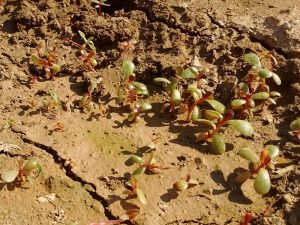
Several drawbacks to the use of solarizing are worth reiterating. If temperatures under the tarp are sub-lethal, it can actually create a ‘greenhouse’ that encourages weed growth. This is likely to occur if plastic edges are not tightly secured, and when the practice is applied too late in the season and there is insufficient sunlight to achieve killing temperatures. Solarizing can also fail in low-lying portions of fields where water pools, creating a cool microclimate. Finally, not all species are susceptible to stale seedbedding with tarps; purslane germination even appeared to be stimulated by solarization (Birthisel and Gallandt, 2019). By contrast, black tarps may fail to result in substantial seed bank depletion if applied under suboptimal conditions but are unlikely to fail so abjectly.
Minimizing tillage with tarps
Introduction
Vegetable farmers in the Northeast increasingly use tarps to prepare beds with minimal or no tillage between crops. The keys to successfully using tarps in this capacity is that tarps must: 1) terminate any living plants (cash crop, cover crop, or emerged weeds), 2) help create a planting bed that is suitable for the following crop, and 3) provide adequate weed suppression in the early period of cash crop growth, if not longer. When applied in this way, tarps provide some or all of the bed preparation services typically provided by tillage. Tarps can help fill a niche for farmers using minimal tillage by creating weed-free planting conditions for the following crop without relying on heavy applications of organic mulches (e.g., hay, straw, leaves, or compost), materials that are not appropriate for short season or direct seeded crops, and can be difficult to source and labor intensive to apply.
There is a range of different applications for this practice, ahead of both direct and transplanted crops, and for multiple planting windows across the season. Farmers frequently put tarps directly over harvested crop residues between plantings or on overwintering cover crops (such as cereal rye) before they have accumulated much biomass in spring. As has been discussed elsewhere, the efficacy of occultation vs. solarization for this purpose depends on the conditions; most farmers in the Northeast use occultation because it is a lower risk strategy, but in summer months some farmers find solarization highly effective.
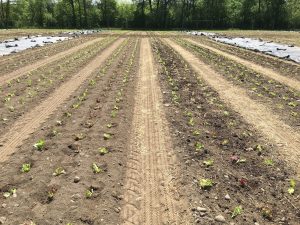
Tarping with minimal tillage between plantings effectively reduces the intensity of tillage used in a rotation and fits into long-term soil health goals like protecting soil organic matter and building soil structure. It can also eliminate field passes – which can be especially valuable in early spring or other rainy periods when soils are otherwise too wet to work and operating equipment may cause lasting damage. Even when cash crop and cover crop residues are minimal, leaving soils undisturbed with some intact roots can help to improve water infiltration and reduce the potential for soil erosion and surface runoff.
Logistics
It is essential to identify and plan for the tarping period in the crop rotation, as tarping takes time. Tarping for three weeks or more is common, though some farmers use much shorter durations (<1 week) when conditions are warmer, like mid-summer or in high tunnels.
Sequences that farmers and researchers have employed include:
- Fall cash crop → overwintering or early spring tarp → spring or summer cash crop
- Spring cash crop → summer tarp → fall cash crop
- Winter-killed or overwintering cover crop → early spring tarp → spring or summer cash crop
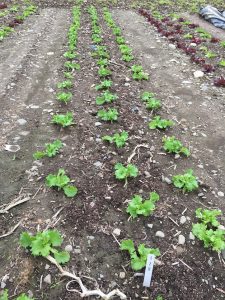
Residue management and seedbed quality are the two main considerations in this system: it is important to consider the conditions the tarped crop will leave behind as well as the conditions that are required for establishing the following crop. For many direct seeded crops, especially those with small seeds, having low amounts of surface residue and a level seedbed is important for establishment and growth. These issues are less of a concern for transplanted crops, making them good candidates for first trialing this practice.
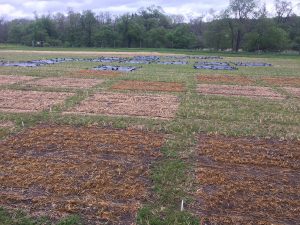
Tarp effects on residue and decomposer organisms are not well documented. Many farmers have observed that tarps appear to expedite residue decomposition and increase activity of some organisms, like earthworms. However, research in New York and Maine found that tarping did not accelerate decomposition of an oat cover crop left on the soil surface, regardless of the tarping duration (3 or 6 weeks in spring or 10+ weeks over winter) (Rylander et al., 2020a). Tarping may sometimes accelerate decomposition but the effectiveness likely depends on several factors including: the history of field management, the soil and weather conditions, the quality of residue (i.e., C:N ratio), and if or how it is incorporated into the soil. Even when heavy residues remain after tarp removal, tarps can make it easier to manage.
It is recommended to combine tarping with other strategies to limit residue interference for no-till crop establishment, including selecting appropriate crops, modifying available planting tools, and physically removing plants. For example, tarping low-residue cash crops (e.g. leafy greens) or crops that will be largely removed by harvesting (e.g. root crops) can minimize interference with planting the next crop after tarp removal. When tarping after higher biomass and stalky crops (e.g. Brassicas) that can lead to excess residue, farmers have cut and removed whole plants at the soil surface prior to tarping, or raked crop residue into pathways — mechanically or with hand tools — after tarping. Flail mowing the previous crop also can be used to finely chop and evenly distribute cash crop or cover crop biomass prior to tarping, though crop stems can persist and may still need to be pulled by hand to avoid poking holes in tarps.
Soil physical conditions are another important consideration before implementing no-till production with tarps. Establishing a system of permanent or semi-permanent beds can help preserve the soil’s structure by limiting field traffic and compaction to between-bed pathways. Even in permanent beds, planting can be more difficult without a tilled, uniform, and friable seedbed. Dry, compacted soil can be especially hard to plant into, whether by hand or mechanically, highlighting another reason to ensure there is adequate soil moisture before tarping. When surface compaction or crusting is a problem, it is common for farmers to use available tools to work the soil surface shallowly (<1”) after tarping to improve the seedbed without bringing up new weed seeds (e.g. power harrow, tine/basket weeder, hand rake). Some farmers have overcome compaction and soil tilth issues in no-till systems by using compost at high rates (>1” annually), though there are other management implications to consider in adopting this approach, including compost availability and cost, application logistics, and potential nutrient loading (see tarping in deep compost). When applying compost and other amendments to meet specific crop nutrient requirements, they can be top-dressed either before or after tarp removal, though applying compost before tarping is advantageous if the compost contains any weed seeds.
Effects and outcomes from minimizing tillage with tarps

Killing established annual weeds. In research where black tarps were left in place for three weeks, they killed all or more than 95% of emerged winter annual and summer annual weeds for no-till planting. This result was consistent when tarps were placed in early (mid-April to May) and late spring (mid-May to June) (Rylander et al., 2020b). Similar results have been found in more recent trials when tarps were used for three weeks in mid-summer (July), after a spring lettuce crop and prior to fall broccoli. Whether applied over harvested cash crops or cover crops, tarps make it possible to suppress established annual weeds without needing to manage or disturb crop residues. If tarps are well timed to kill weed escapes, before they go to seed, they can also indirectly help to manage the weed seed bank. In trials that have documented the labor associated with tarping in continuous no-till (Maher et al., 2017), the ability to kill established weeds prior to planting has been shown to provide significant labor savings, reducing labor for no-till systems by 40%.
Weed emergence and competition in the following crop. Although fatal germination of weed seeds has been observed with tarping in no-till systems, it is likely less effective at drawing down the weed seed bank than stale seedbedding with tillage and tarps because there are fewer germination cues. Research that looked at weed emergence after no-till planting found that tarp durations in excess of 3 weeks did not provide additional benefits (Rylander 2019a). Other research in a continuous no-till tarped system has shown that tarps can reduce annual weed emergence when compared to conventional tillage over multiple years (Maher et al., 2017). This is likely the combined result of tarps: 1) increasing fatal germination, 2) suppressing weeds between crops that would otherwise produce seed, and 3) eliminating soil disturbance and the introduction of weed seeds from greater soil depths. It is likely that some additional in-season weed management tactics will be necessary in these applications, especially for long season crops and to suppress perennials, unless significant previous efforts have drawn down the weed seed bank or a weed suppressive crop is grown.
Retain and increase soil inorganic nitrogen for the following crop. No-till soils often show lower soil N availability compared to conventionally tilled soils. However, after tarping, crops can inherit a large amount of plant-available soil nitrogen in the form of nitrate. Longer tarp durations typically increase soil N availability, helping farmers overcome one of the previous limitations of no-till production.
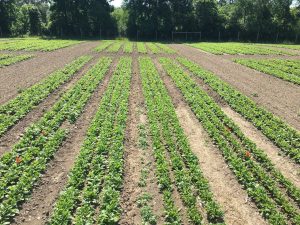
Crop establishment and yields. Across several trials in New York and Maine, a no-till system with tarping has produced equivalent crop yields to conventional tillage (Maher et al., 2017; Rylander et al., 2020b). When trialing direct-seeded beets, tarped no-till beds led to equivalent or better crop stands when compared to untarped and conventionally tilled beds. These results are likely due to the combined effects that have previously been discussed: weed-free planting beds, conserved soil moisture, and elevated soil nitrate at planting. Similarly, in a 4-year continuous no-till system using tarps, crop yields of cabbage and winter squash were equivalent to conventional tillage, though a no-till tarp system did require 25% more labor due to the time needed to manage tarps.
Killing cover crops. Tarps can be an effective no-till termination strategy for winter hardy cover crops (e.g., cereal rye) prior to spring cash crop planting. Rather than growing the cover crop to produce a weed suppressive mulch, farmers are killing cereal rye in spring (early to mid-May) when earlier cash crop plantings and lower residue conditions are desired. Cover crop benefits in this application include protecting soil with living ground cover over winter, which can reduce soil erosion and retain mobile nutrients. In NY, tarps have been shown to terminate cereal rye within three weeks between late April and mid-May with similar results using black plastic, woven landscape fabric, and clear tarps with the edges sealed.
Drawbacks
There are some unique challenges to consider when trialing tarps in no-till applications. Primarily, rough, uneven planting conditions and surface soil compaction can become a bigger issue when using no-till over multiple years. This can be especially challenging in heavy or rocky soils. It may be necessary to complement tarping with a shallow tillage pass (<1”), plan for additional planting labor, or modify the planting approach – either by modifying tools or transplanting rather than direct seeding – to improve crop establishment under these conditions. Research and farmer experiences have also shown that tarping without supplemental weed management tactics in a no-till system does not provide reliable season-long weed suppression for the following crop, especially in soils where the weed seed bank is high. Just as incorporating multiple weed management strategies is necessary to avoid problematic weed species, incorporating additional soil health-building practices are recommended to complement tarping practices to improve soil tilth and increase overall soil health.
Cover crop-based rotational no-till with tarps
Introduction
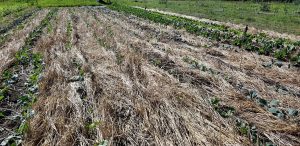
Cover crop-based organic rotational no-till was originally developed as a system in which high biomass cover crops like rye and vetch are terminated mechanically with a roller-crimper. A subsequent cash crop is planted into the residue without additional tillage. Despite myriad benefits, this system as it was originally conceived has several limitations for small-scale growers in cooler regions like the Northeast. A roller-crimper is a specialized piece of equipment that is only effective at specific cover crop growth stages. Furthermore, the biomass required to provide season-long weed suppression (>7000 lb/acre) is often hard to achieve with long winters in the north. Integrating tarps has helped overcome these challenges and made this system accessible because it eliminates the need for specialized machinery and provides flexibility in the timing of cover crop termination. Tarping also augments the weed suppression provided by cover crop residue, allowing successful implementation even with lower levels of cover crop biomass.
Leaving cover crop residue on the soil surface as a mulch for the cash crop has important benefits: the residue suppresses weeds, conserves moisture, and protects soil from intense precipitation events. In this system, it is possible to let the cover crops grow very large without worrying about the equipment needed to incorporate biomass. Cover crop-based organic rotational no-till includes three of the most important management practices for improving soil health—growing high biomass cover crops, leaving a mulch on the soil surface, and reducing tillage. Furthermore, when a legume cover crop is included, it adds valuable nitrogen and reduces fertilizer requirements for the cash crop.
This system requires that farmers commit the time and space needed to grow and terminate high biomass cover crops, but it reduces the need for purchasing additional external inputs such as straw mulch and fertilizer, and can reduce irrigation requirements. Most farmers practice “rotational” no-till—not continuous— with cover crops, often relying on tillage prior to cover crop establishment. However, some farmers using the deep compost continuous no-till method with tarping have started using high biomass cover crops more often, with the goals of reducing the amount of compost they apply and reaping the benefits of a mulch grown in place.
Logistics
Resources, tools, equipment, supplies
Establishing cover crops: In addition to a tarp, this system requires an even cover crop stand with high biomass, a way to lay down or roll the cover crop, and a method to plant through the cover crop residue. To establish an even cover crop stand without bare patches, it is critical to get uniform seed distribution and good seed-soil contact. On a small scale, this is possible either by broadcasting or “drilling” using a push seeder like an Earthway. Timing with soil moisture and forecasted rain or irrigation in mind is always advised.

Rolling cover crops: Rolling the cover crop prior to tarp application is the best way to lay it down. In addition to creating stubble that can poke holes in tarps, mowing often chops up residue, leaving it unevenly distributed on the soil surface. Rolling lays all residue in one direction, making transplanting easier. Tools that work for rolling include a lawn roller, which can be pulled by a riding mower or manually, a disengaged rototiller or flail mower, and one or two people with a board on strings.
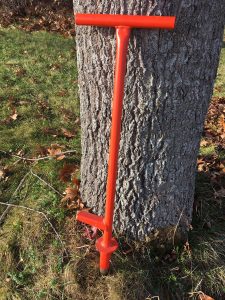
Transplanting: Transplanting through the cover crop residue usually requires a special tool unless the soil has been amended with very large amounts of compost. Some farmers have made tractor-mounted transplanters, but on a small scale something like a tree dibbler can be effective to create a hole in the soil, into which the transplant is placed. As with other operations, soil moisture plays a large role in the ease of creating holes. For this and other reasons discussed throughout the guide, applying the tarp when soil moisture is optimal and only removing it when the field is ready to be planted ensures that this process will not be hindered by dry soil and that transplants will have adequate moisture.
Timing and duration
This system requires significant planning in advance. The period of cover crop growth, date, and duration of tarping, and date of cash crop planting must all align. For the purposes of this guide, this section focuses on winter hardy cover crops like rye and vetch that are planted in fall and terminated in summer. This timing does not work for early planted cash crops, but it does for later planted cash crops like fall broccoli and other Brassicas (see case studies). Other sequences that differ in timing and crops (e.g. a spring/summer cover crop followed by a fall cash crop) but still follow the cover crop — tarp — no-till cash crop pattern could be effective.
Each location and season is different, but there are some general considerations when planning the critical steps in this system:
- Fall cover crop planting: Although there are some advantages to planting rye and vetch as early as August, a September planting is often most feasible in the Northeast. If planted later, like the beginning of October, higher seeding rates (>180 lb/acre) can compensate for some of the lost early growth and tillering. Vetches run the risk of not surviving winter if planted too late, and it is typically recommended that they be seeded >30 days before the first killing frost.
- Spring/summer tarp application date: Growth in spring is much more important than fall growth for biomass and nitrogen accumulation; in the mid-Atlantic, it takes two months of extra growth in fall to equal 10 days of extra growth in spring (Mirsky et al., 2011). Data from two years in New Hampshire and Maine illustrate the rapid growth that occurs in spring, first for rye and then for vetch. Allowing cover crops to grow to peak biomass (in full flower, but before seed set) before applying a tarp has many benefits including the greatest production of mulch leading to the highest weed suppression, and the greatest nitrogen fixation from the vetch. As with all tarping applications, soil moisture must be adequate when tarps are applied. In a dry season, it is possible that the growing cover crop will deplete soil moisture and irrigation may be necessary, but in a wet season this system increases flexibility because fields are accessible and no spring tillage is required.
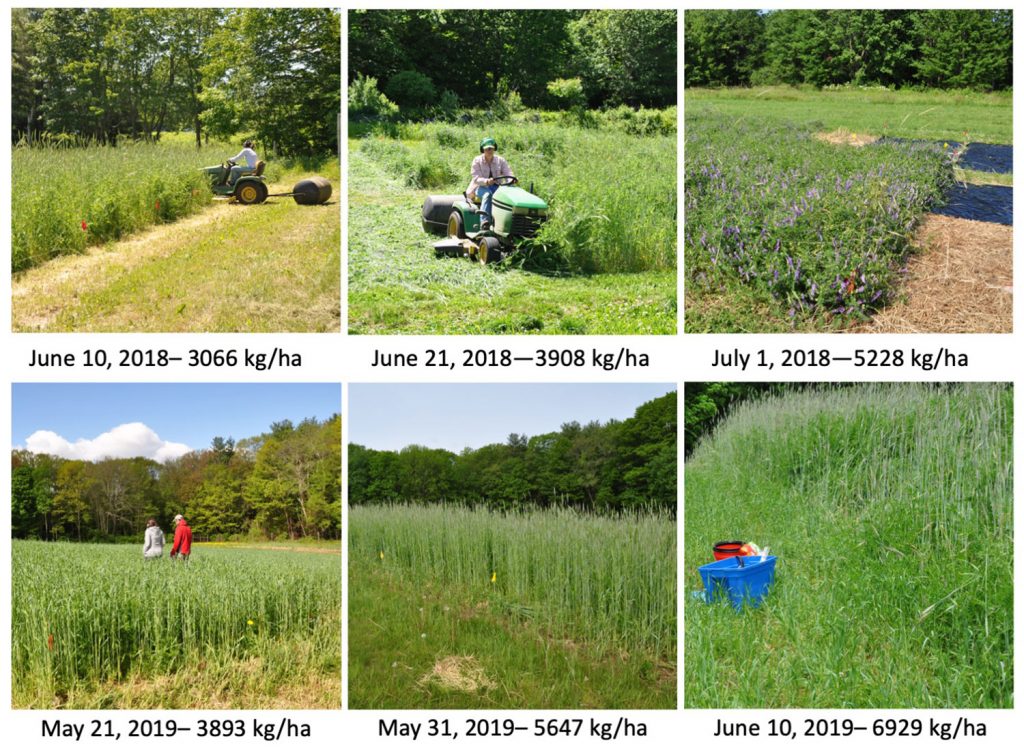
- Tarping duration: The primary goals of tarping in this system are to terminate cover crops and suppress weeds. A secondary goal is to manipulate nitrogen availability. The duration of tarping required to meet these goals is tied to the time of tarp application and the amount of biomass produced and nitrogen fixed. In other words, earlier tarp application dates may require longer durations (>10 days) to terminate cover crops effectively and provide adequate weed suppression, while later termination dates require less time (<10 days). This is because cover crop termination is easier when air temperatures are higher and cover crops have reached anthesis, and weed suppression is increased with greater cover crop biomass—thus the system relies less on the effects of tarping itself to suppress weeds. Some farmers have reported applying tarps on very high biomass cover crops for 2-3 days in summer resulting in complete termination. As with other tarping applications, longer durations do lead to higher soil nitrate levels.
Effects and outcomes from cover crop-based rotational no-till with tarps
Weed suppression: This system has the potential to be highly weed suppressive, offering nearly season-long weed suppression and therefore eliminating or dramatically reducing the need for weeding during crop production. When cover crop biomass levels are low, however, additional in-season weeding is required unless density of the weed seed bank and bud bank are already very low.


Nitrogen: When incorporated, some cover crops with high C:N ratios like winter rye have been known to immobilize N, leading to greater fertilizer requirements. Leaving mulch on the soil surface, rather than incorporating the residue, changes nutrient cycling dynamics. Although research has not investigated the N dynamics of tarping winter rye alone, data have shown that tarping winter rye and hairy vetch bicultures leads to high levels of available nitrate (e.g. >20 mg kg-1) 20-30 days after tarp application.
Drawbacks
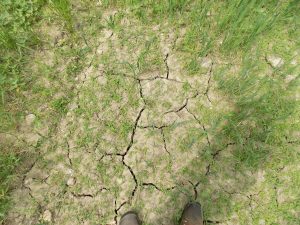
Soil quality, the evenness and quantity of the cover crop stand, and the weed seed bank present are all important to consider before trying this system. Poor soil quality, especially on compacted high clay soils, can limit growth of the no-till planted cash crop. A sparse, uneven, or poorly growing cover crop will not provide adequate mulch and weed suppression throughout the growing season, even if weeds are terminated by the tarp. If there is a known soil quality or weed seed bank problem, it may be advisable to work to ameliorate these problems before attempting to implement a cover crop-based no-till system with tarps.
One of the drawbacks of this system is that if weed suppression is insufficient, mechanical cultivation is not possible because of the mulch present. Hand weeding can be—although it isn’t always—more time consuming than in a tilled system, depending on the species present and moisture content. Because mulch increases soil moisture, weeds are often easy to pull by hand.
Continuous no-till with deep compost mulch and tarps
Introduction

A growing number of farmers are combining tarping with deep compost application, sometimes termed compost mulching, to help transition to a high-yielding continuous no-till vegetable production (Mefferd, 2019). Compost is a valuable soil amendment with many well-known benefits for soil health that provides a slow-release organic nutrient source for crops. Deep compost can quickly transform the native soil and form a layer of surface mulch that suppresses weeds and alters the soil’s physical, biological, and chemical characteristics.
When used as a soil amendment to account for specific crop nutrient needs, typical compost application recommendations range from 10-20 cubic yards per acre annually, or approximately 1/10 inch. The deep compost no-till method uses compost in much higher quantities—often more than twenty times this rate— which can result in excessive nutrient levels that pose a pollution risk.
Tarping can provide several complementary benefits to a deep compost system. For example, tarping can create weed-free conditions for compost application and provide supplemental weed suppression to control weed escapes that emerge through the mulch. In this way, tarping may help advance this system by enabling farmers to use lower compost rates or reduce compost use over time. Given the nutrient-rich conditions, impermeable tarps can also help retain mobile soil nutrients that are at risk for leaching in the absence of a cover crop, especially in an overwinter application. Tarps can also facilitate high biomass cover crop adoption in this system, which some no-till farmers have been cautious to introduce without an effective termination strategy.
Effects and outcomes from tarping in deep compost mulch
Deep compost mulch can be used to bury weed seeds and reduce weed emergence though the effectiveness is likely dependent on compost application rates and the weed species present. Researcher and farmer experience in this system has shown that some weeds can persist, especially perennials, and that new weed seeds can also be introduced through the compost. When comparing a no-till compost mulch with and without tarping, research has shown that tarps significantly increase the effectiveness of this method by providing supplemental weed suppression for these weed escapes and saving hand weeding labor, primarily by killing living weeds prior to planting. Light, fine textured compost on the surface impacts soil tilth in ways that change the efficiency of hand labor tasks: some weeds are easier to pull and remove, and hand hoeing can be faster. Farmers have found that no-till transplanting by hand is easier in these systems, eliminating some planting constraints associated with surface compaction in no-till systems.
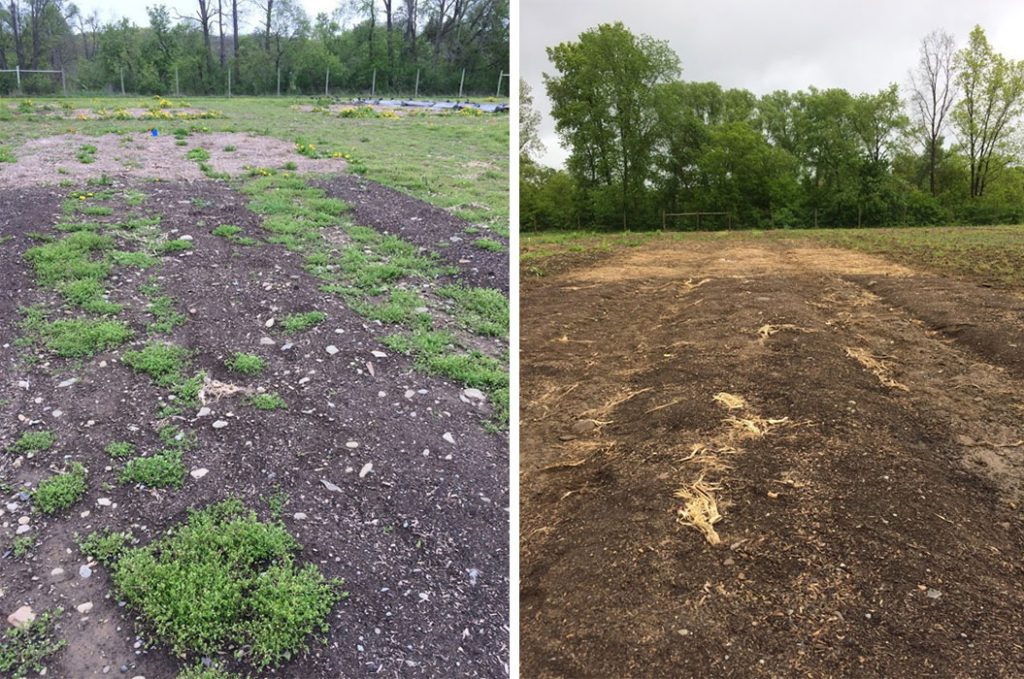

Research from New York quantifying weeding labor costs, labor to handle and apply compost, and crop yields over four years, showed that including tarping with a deep compost no-till system can increase profitability. Importantly, tarping without the addition of deep compost also provided weed-free planting beds using equivalent labor, which suggests that tarping can reduce the quantity of compost needed for effective weed control. Applying manure-based compost at mulching rates (1.5” annually) raised organic matter content in the surface soil (0-8”) at an average rate of 1% per year in New York and Maine, and increased no-till crop yields by as much as 25%.
Drawbacks
There are several constraints to farmer adoption of this system that center on heavy compost use. These include concerns over the high potential for nutrient loading, high compost cost and limited availability, and the time and labor associated with application. Nutrients are often imported at levels that far exceed crop demands, especially phosphorus and nitrogen with manure-based compost. Soil tests from farms using these systems have revealed phosphorus levels well above the optimum range. In research trials spanning four years, application of 1.5” of compost annually increased soil test P levels eightfold—from below optimal to four times the upper optimal limit. High quality purchased compost can be prohibitively expensive and with growing demand, many farmers have reported difficulty procuring enough compost to meet their needs. Applying compost can also be challenging or highly labor-intensive for farmers that have limited labor or lack equipment for compost application.
Bringing sod into production
About half of farmers surveyed who already use tarps have used them to bring sod into production (Rangarajan, 2019). Details on the most efficient and effective methods are lacking and are likely highly site-specific, based on soil type, soil health, the living plants present, and the weed seed and bud banks. It is possible to transition some soils that have good tilth and organic matter straight into production without tillage, by terminating sod with tarps. However, compacted soils with low organic matter and poor tilth may require amendments like compost, some tillage, and soil building cover crops before making this transition. In the absence of perennial weed problems and a robust bud bank, it may be possible to terminate sod and weeds within 4-6 weeks. However, some farmers have found that nearly a full season (i.e. four months) of tarping is necessary. In any case, it is advisable to monitor weeds closely following sod termination to address any problems that emerge. The ongoing use of woven landscape fabric tarps when transitioning sod to perennial production is a related application that can help successfully control perennial weeds.
Overwintering for early season production
When tarping over winter, beds are prepared in late summer or fall and covered in preparation for planting the following spring. By excluding snowfall and spring rains, impermeable tarps can keep soils from waterlogging, increase soil temperatures by a few degrees, allow for early field access in spring, and retain leachable soil nitrate. Many farmers consider this as a major benefit, where these tarped beds serve as some of their first beds for spring planting. This can be especially valuable on fields with heavy, poorly drained soils. Overwintered tarps can also provide soil cover on bare ground after late fall crops when cover crop planting windows have passed. Tarping over winter suppresses winter annual weeds like chickweed that germinate in late fall and early spring, and gives spring greens and other early cash crops a head start. Despite these benefits, overwintered tarps can create headaches if not secured well or located on windy sites. They require a set of eyes on the field and will likely require adjusting in the absence of good snow cover and after periods of heavy wind.
In complying with the letter and spirit of applicable laws and pursuing its own goals of diversity, the University of Maine System does not discriminate on the grounds of race, color, religion, sex, sexual orientation, transgender status, gender, gender identity or expression, ethnicity, national origin, citizenship status, familial status, ancestry, age, disability physical or mental, genetic information, or veterans or military status in employment, education, and all other programs and activities. The University provides reasonable accommodations to qualified individuals with disabilities upon request. The following person has been designated to handle inquiries regarding non-discrimination policies: Director of Equal Opportunity and Title IX Services, 5713 Chadbourne Hall, Room 412, University of Maine, Orono, ME 04469-5713, 207.581.1226, TTY 711 (Maine Relay System).

